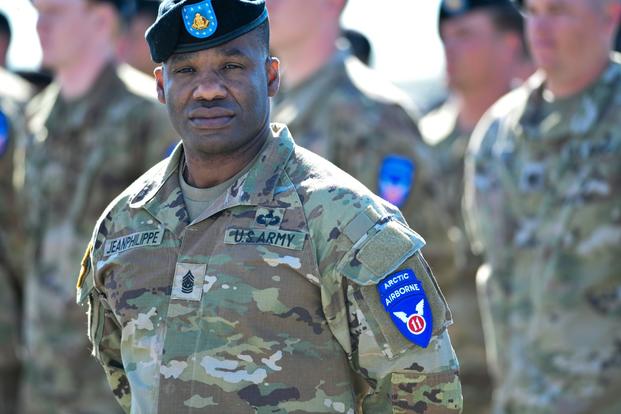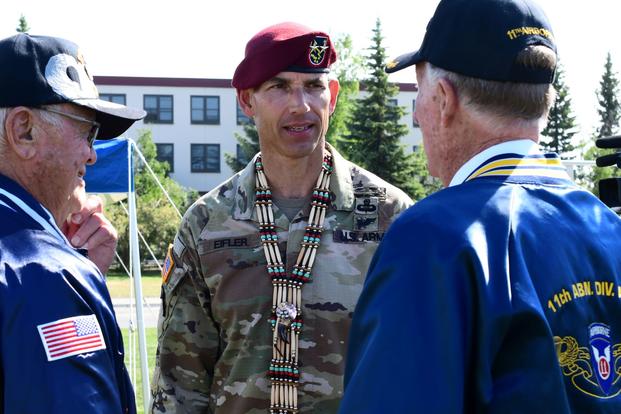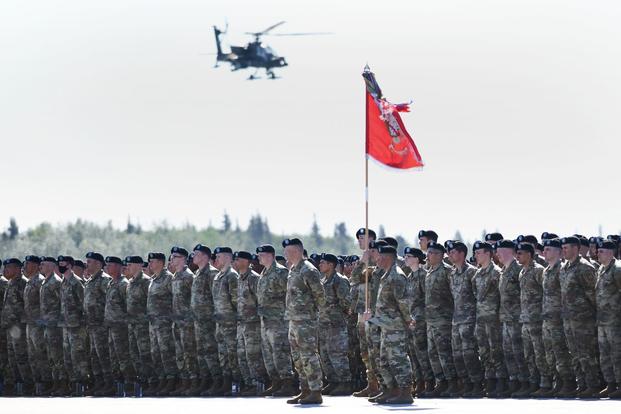Read the original article on Business Insider.
The U.S. Army activated the 11th Airborne Division in Alaska this week, reestablishing it as an Arctic-focused unit in what the Pentagon sees as a valuable outpost to project power in the region, into Europe, and across the Pacific.
"We expect them to be masters of their craft in the Arctic warfighting, in extreme cold weather, in mountainous and high-altitude terrain, and we expect them to develop innovative ways of operating in this environment," Army Chief of Staff Gen. James McConville said at a press conference on Monday.
The two major Army units in Alaska — the 1st Stryker Brigade Combat Team based at Fort Wainwright and the 4th Infantry Brigade Combat Team (Airborne) based at Fort Richardson — were previously under the Hawaii-based 25th Infantry Division.
Those units, along with the headquarters unit U.S. Army Alaska, are now part of the 11th Airborne Division — a redesignation that Army leaders say underscores the unit's Arctic orientation and will enhance its soldiers' sense of mission and identity.
"There's a collection of different unit patches that we're all wearing right now," Maj. Gen. Brian Eifler, who led U.S. Army Alaska and now commands the 11th Airborne Division, said at the press conference. "What we're doing is consolidating under one."
"Arctic warfighting is not just what they do. It's really who they are, and that's the identity that these great soldiers are going to have in the 11th Airborne Division," Eifler said.

Survive and thrive in the Arctic
The Army Arctic Strategy released last spring emphasized the need for Arctic-specific training and equipment and infrastructure that could support operations over the region's long distances and tough terrain.
The Army conducted a "gap analysis" to determine what was needed and sought to address "near-term deficiencies" in its 2023 budget request. In that request, Army asked for $101.8 million to support the strategy by buying 13 new cold-weather, all-terrain vehicles, acquiring more Arctic clothing and gear, and continuing to winterize equipment, an Army budget official said this spring.
The budget official also said that money would cover "exportable" Combat Training Center rotations, allowing Alaska-based troops to do large-scale training in Alaska rather than the Army's training centers in Louisiana and California.
Training in Alaska allows soldiers "to train the way we're going to fight" and fielding new vehicles along with "the right equipment and the right clothing" means they will "not only survive in this environment but they will thrive," McConville said Monday.
The 1st Stryker Brigade Combat Team will shed its more than 300 Stryker vehicles, which will be upgraded for use elsewhere or stripped for parts, and become a light or air-assault-capable infantry brigade combat team, Eifler said.
"The structure of the organization will change slightly inside of it," Eifler said of the Stryker unit, "but their focus will be on dismounted [operations] and Arctic mobility and capabilities to sustain operations in the Arctic, in extreme cold weather, and in addition to providing those capabilities in other cold-weather environments, like Nepal and India."
The airborne brigade will remain airborne "and it'll have the Arctic capabilities that go along with that," McConville said.
"You're going to see a lot more training in the [Alaskan] training areas, dismounted. You'll probably see a lot less Strykers [and] maybe a little bit more airborne operations up here, because again, the only Arctic airborne capability is in this unit," Eifler said.
'A tough new airborne division'
The 11th Airborne Division was first activated in February 1943. Its paratroopers and glider-borne soldiers fought in the Pacific and developed tactics and concepts for airborne operations during and after World War II.
The division has "a storied history of valor" and "a proud history of innovation," McConville said. "They were the ones that actually tested and validated the effectiveness of division airborne operations that actually gave confidence to the leaders that it could be used during D-Day."
Eifler said the former Stryker brigade will "spearhead" the effort to "refine and develop our techniques, tactics, and procedures, our equipment, [and] the structure that's needed to fight and win in the Arctic."

That effort will draw on soldiers and equipment in Alaska and on allies and partners — "the Canadians and Norwegians and folks around the world," Eifler said.
Alaska-based soldiers regularly train with Canadian forces, and in May, Alaska-based paratroopers trained in Norway for the first time, an exchange that Norwegian and U.S. officials want to continue.
U.S. Army Alaska soldiers trained with Indian troops in October during the Yudh Abhyas exercise and plan to train in India later this year.
Eifler said Monday that Nepalese army officials are also interested in training together: "They want to do a joint expedition on Everest with us, and they want to do a lot more training with this Arctic force."
Those exercises reflect Alaska's role in defense of the US and in operations in Europe and the Indo-Pacific region, which the Pentagon wants to capitalize on amid increasing competition with Russia and China.
"I think what's happening today represents a sea change in the Pentagon's focus on the Arctic," Sen. Dan Sullivan said at the press conference on Monday.
"With the 11th Airborne Division, we now have a strategically located, tough unit that can deploy thousands of airborne troops anywhere in the world," Sullivan said. "Just take a look at a map, very quickly, within hours, [it can reach] Korea, China, Russia, you name it."
The Army has about 12,000 soldiers in Alaska and doesn't currently plan to change that, but other services are "plussing-up" their presence. The Air Force has deployed 54 F-35s to join the F-22s stationed there, and the Navy is looking at additional basing and ports.
"China, North Korea, and Russia are soon going to realize that the US just put 100 fifth-gen[eration] fighters and a tough new airborne division in their rear and on their flanks," Sullivan said. "Although that might not make Putin and Xi Jinping happy, it enhances our national security for our country very significantly."
Don't Miss a Single Military.com Story
To read the full article and get exclusive benefits, sign up today.
It’s FREE
Why am I seeing this? Visit our FAQs












